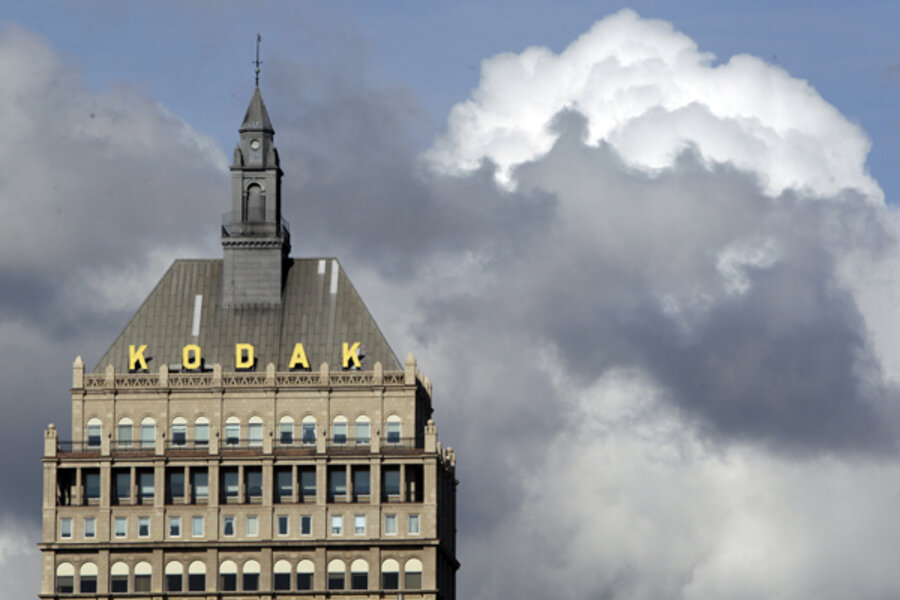Bankruptcy protection: Kodak makes moves to stave it off
Loading...
| ROCHESTER, New York
An uncomfortable suspicion that an icon of American business may have no future pushed investors to dump stock in Eastman Kodak Co. Wednesday.
The ailing photography pioneer's shares fell to a new all-time low after the Wall Street Journal reported that Kodak is preparing for a bankruptcy filing "in the coming weeks" should it fail to sell a trove of 1,100 digital-imaging patents.
Analysts have said the patents could fetch $2 billion to $3 billion, but no takers have emerged since Kodak started shopping them around in July.
In November, the 131-year-old company said it could run out of cash in a year if it didn't sell the patents. Even as it looked to a future rooted in its emerging printer business, the company was reporting a third-quarter loss of $222 million — its ninth quarterly loss in three years — and it said its cash reserves had fallen 10 percent in three months.
Now, Kodak finds itself in a state of suspended animation.
"Everybody has a sinking feeling," said Ulysses Yannas, a Buckman, Buckman & Reid broker in New York. "It's possible they can file for bankruptcy protection. Yet I don't think it's probable — principally because the need for cash is not imminent."
Kodak's shares tumbled 18 cents, or 28.2 percent, to close Wednesday at 47 cents and continued falling after hours. They hit their previous trading low of 54 cents on Sept. 30 when word leaked that Kodak had hired a law firm that advises companies on bankruptcy and restructuring options.
In the dozen years before 2011, the company had lost more than 95 percent of its value as it was pummeled by foreign competition and then shaken to its core by a digital revolution. It launched the plan to sell off key assets as its shares fell another 80 percent in 2011, having started the year at about $3.
"It feels like water torture," said Mark Zupan, dean of the University of Rochester's Simon Graduate School of Business Administration. "The game hinges on that (patent) sale, principally. And, at this point, they just have to create the insurance if they've got to go the other route. But the prospect of bankruptcy makes the sale more complicated too."
The New York Stock Exchange warned Kodak this week that its shares would be "delisted" — or dropped from the exchange's listings — if they stay below $1 for six more months.
The Journal said Kodak is in discussions with potential lenders for around $1 billion in loans called "debtor-in possession financing" that would keep it afloat during a bankruptcy process. The newspaper said a bankruptcy filing could occur by early February.
A Kodak spokesman said the company does not comment on rumor or speculation.
Three members of Kodak's board of directors have resigned in the past two weeks. The latest was economist Laura Tyson, a member of the Clinton Administration and a former dean of the Walter A. Haas School of Business at the University of California, Berkeley.
Since 2005, Kodak has poured hundreds of millions of dollars into new lines of inkjet printers that are finally on the verge of turning a profit. Home photo printers, high-speed commercial inkjet presses, workflow software and packaging are viewed as Kodak's new core.
Revenue from those businesses rose by a combined 13 percent in the third quarter, and Kodak said it expected the consumer printer to become profitable in the October-December quarter, typically the period that generates the bulk of its revenue. Kodak reports its fourth-quarter results on Jan. 26.
Kodak is hoping the printer, software and packaging businesses will more than double in size by 2013 and account by then for 25 percent of its revenue, or nearly $2 billion.
As Kodak's cash reserves shrank to $862 million in the third quarter from $957 million in June, it set a new year-end cash target of $1.3 billion to $1.4 billion that excludes any intellectual-property licensing deals, down from a previous forecast of $1.6 billion to $1.7 billion.
For years, Kodak has been sustaining itself in part by mining its inventions for revenue — and the hoped-for sale of its digital inventions represents a sharp tactical shift.
That could be because Kodak picked up just $27 million in patent-licensing fees in the first half of 2011, compared with $1.9 billion in the previous three years. It expects to generate more than $340 million in the current quarter from at least two patent-licensing deals and the sale of non-strategic assets.





